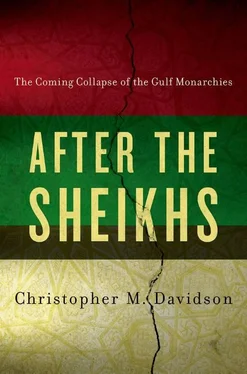Although the Omani ruling family’s outlook is less precarious than Bahrain’s, with the state not suffering from the same levels of sectarian strife or discrimination, nor having had to invite troops from neighbouring countries to assist in suppressing protests, there are nonetheless serious concerns about political stability. As with Bahrain, Oman only has limited resources and cannot rely indefinitely on creating public sector opportunities for its citizens in order to appease protests and demands. Indeed, Oman’s stability already rests on external assistance, mostly from Saudi Arabia, and over the next year or two this will serve to delegitimise the aging, heirless ruler and his government. Moreover, when fresh protests erupt — either as a result of continuing government corruption or the state’s likely failure to deliver on its economic promises — these will undoubtedly be met with an even heavier response than the 2011 riots, as the ruler’s new backers will be unwilling to tolerate fresh challenges to another monarchy on its doorstep.
In many ways the kingpin of the Gulf monarchies, Saudi Arabia’s ruling family may appear more stable than its Bahraini and Omani neighbours given that its government still has the ability to keep distributing wealth in order to appease citizens; but in reality the Saudi system is equally unsustainable and probably prone to implosion within the next couple of years. With ongoing demonstrations regardless of the new subsidies and job creation schemes, and with increasingly repressive tactics being used to suppress freedom of expression, the kingdom is now looking very brittle. If, as is likely, conditions in Bahrain deteriorate further, then more serious protests and even revolutionary activity will occur, especially in Saudi’s Shia-dominated Eastern Province. And if unemployment, the wealth gap, and other socio-economic problems remain unchecked it is probable that insurgency will spread further across Sunni communities, thus helping the reform movement gain much broader support beyond the Shia population.
The most recent Saudi protests and demands have already been quite varied, occurring all over the country. They have ranged from men [980] 7. Feras Bughnah and Hosam Al-Deraiwish.
being arrested for filming and then uploading onto YouTube a video about widespread poverty among Saudi nationals in Riyadh — a video which has now been watched by more than 1 million, [981] 8. This took place in late October 2011.
to women in Jeddah, Riyadh, and the Eastern Province filming themselves driving on motorways — a flagrant act of civil disobedience given the prevailing ban on women driving. The women involved tweeted that they were carrying their belongings as they were ‘ready to go to prison without fear’ while others told the international media that ‘this is a right for women that no law or religion bans… [we] went out to get our rights, so that it would be up to us to drive or not’. [982] 9. Agence France Presse, 17 June 2011.
As expected, Facebook and Twitter are also playing a key role, with leading activists claiming that ‘they can now speak to thousands across the world… without the strict censorship they live under in the off-line world’ and that ‘we’re so thirsty for freedom of expression and a forum for expression that you see [we] are far more involved [in social media] than our neighbours’. Certainly, as the aforementioned Muhammad Fahad Al-Qahtani has claimed, ‘the government has underestimated the power of social media in Saudi Arabia and now it’s too widespread to censor’. [983] 10. Time Magazine , 12 July 2012.
Meanwhile there are now frequent samood or ‘resistance salons’ being held in the villas and apartments of known activists, despite some having already been threatened with the death penalty. Writing in the Washington Post in April 2012 one of these embattled figures, Waleed Abu Alkhair, related that such events are giving him ‘the pleasing epiphany that religious hard-liners have begun to lose control of a young generation that is hungry for freedom’. He gave the recent example of a ‘brave young man who responded passionately to clerics [also] invited to participate in the salon and who had threatened him for supporting freedom of expression and belief’. According to Alkhair, the young man replied to the clerics by asking ‘Who are you? Who are you to inflict your religious guardianship upon us?’ and then stating ‘We are free, free to say what we like. You are just like us, not better. The era of religious guardianship is over’. [984] 11. Washington Post , 20 April 2012.
Similarly, other Saudi activists have been congregating in ‘safe houses’, claiming that their country is little more than a ‘prison’, and arguing that ‘we are not far away from the uprisings that are happening in other countries’. [985] 12. Time Magazine , 12 July 2012.
Indeed, fresh protests outside ministries by unemployed graduates have been staged in Jeddah and Riyadh. At these events participants lamented that ‘…after seven years of unemployment we have no other choice’ and ‘[we] plan to stay here until we find a solution’, while — rather worryingly for the government — others stated that ‘we expect to hear promises to calm us down and disperse us but we will be back. We will be back until they find a solution’. [986] 13. Reuters, 4 October 2011.
And more seriously, in January 2012 following the killing of a young Shia man [987] 14. Issam Muhammad Abu Abdallah.
by police due to their ‘indiscriminate use of force’ a reported crowd of thousands or even tens of thousands took to the streets of Awwamiya to commemorate his death. Together with several other dead activists he is now being described as a martyr in the Eastern Province, and the opposition movement is increasingly being referred to as the ‘Intifada of Dignity’. [988] 15. The Guardian , 23 January 2012. Quoting Toby Matthiesen.
A total of ten protestors are believed to have been killed since the beginning of the uprising with regular firefights now taking place, [989] 16. BBC News, 4 August 2012. On 4 August 2012, for example, both a policeman and a protestor were killed in a firefight, as a security patrol was attacked by rioters on motorbikes.
and in July 2012 one of the regime’s strongest critics was badly wounded by security forces. [990] 17. The Economist , 14 July 2012. Referring to Nimr Al-Nimr, who had earlier called for the Eastern Province to secede from Saudi Arabia if Saudi Shia could not live with dignity.
In Kuwait’s case, with the ruler choosing to dissolve parliament in June 2012 rather than allow calls for anti-corruption investigations to continue, and asserting that the election result was ‘illegal’, he has undoubtedly made his position even weaker. With opposition MPs claiming that his self-described ‘final and unchallengeable decision’ amounts to being a ‘coup against the constitution’, [991] 18. BBC News, 12 June 2012.
it is likely that the government will find it much harder to keep control over future protests. Indeed, most of the recent examples of dissent have been dealt with in a very heavy handed manner. In April 2012 a young Kuwaiti Twitter user was jailed for posting blasphemous tweets about Prophet Muhammad, [992] 19. Hamad Al-Naqi, who was later stabbed while in prison. See Arab Times , 19 April 2012.
while in July 2012 even a member of the ruling family [993] 20. Meshaal Al-Malek Al-Sabah.
was arrested following his tweets that he wanted to stand in the next parliamentary elections and ‘expose corruption among top officials’. [994] 21. Gulf Today , 20 July 2012.
Thus, while Kuwait may not yet have witnessed the violent confrontations that have occurred in Bahrain, Oman, and Saudi Arabia, the outlook for its ruling family is perhaps just as bleak, with the monarchy’s traditional authority being gradually eroded by a more confident and demanding citizenry that has already proven that it can embarrass and contain the ruler and his appointed prime ministers.
Читать дальше












